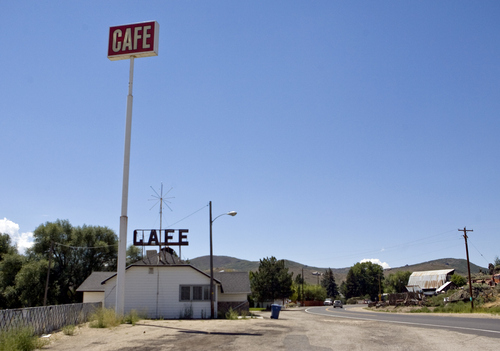This is an archived article that was published on sltrib.com in 2013, and information in the article may be outdated. It is provided only for personal research purposes and may not be reprinted.
Several weeks ago while driving painstakingly slowly on gritty back roads to view the migration of swans, I thought about America's love affair with mobility — and Indianapolis Speedway founder Carl G. Fisher, who said motorcars would travel only as far as they "had good roads to run on."
The year was 1912. The automotive industry was mass producing affordable cars for the middle class. More than 700,000 automobiles were on the road, and good roads were rare. Fisher — manufacturer of Prest-O-Lite headlights — envisioned a paved coast-to-coast highway that spanned 13 states from New York to California, including Utah.
The charismatic entrepreneur believed the nearly 3,300-mile-long road, which became the Lincoln Memorial Highway, would be kind to car chassis, delight motorists, increase tourism, bring more products to market and boost the country's economy.
In 1913, Fisher and other like-minded industry men with deep pockets established the Lincoln Highway Association (LHA) and set about making this $10 million dream a reality.
The LHA gleaned ideas from the Good Roads Movement, founded in 1880 by the League of American Wheelman. They created elaborate publicity campaigns, pursued state and local funding and held meetings that drew huge crowds across the country. An estimated 500 people (including Utah Gov. William Spry) attended a rousing rally held at Lagoon.
"These gatherings were as important in the West as everywhere," LHA treasurer and author Jesse Petersen told me recently from his home in Tooele. "People had cars, rural roads turn to mud in winter, dust in summer, and it was difficult to go anywhere."
To prove they could, the association staged "Seedling Miles" exhibitions.
"They'd get local cement companies to donate concrete and build a nice, mile-long, two-lane concrete road just outside a town," Petersen said. "The idea was once people drove on those sections and saw how wonderful it was to have a paved road, they'd ask their representatives to get involved."
Matching LHA funds with state-provided labor, Lincoln Highway's 1913 proposed Utah route followed Indian pathways, the Mormon trail, the Overland Stage line and the Pony Express.
Crossing the Wyoming state line, the road went through Castle Rock, Echo, Coalville, Wanship, Kimball Junction and Salt Lake City to Grantsville, Fish Springs, Callao, the old Gold Hill and Ibapah toward Ely, Nev.
Some of these routes rattled Spry, who persuaded the association to travel northward from Echo and Weber Canyon to Ogden before going to Salt Lake City. For 18 months, this 36-mile deviation was part of the official route.
But after monitoring traffic patterns, the Ogden route was rescinded and the original plan restored. It was rumored that Ogdenites, miffed by the association's initial rejection, were misdirecting tourists onto other roads.
As highway construction moved westward in 1919, the LHA avoided some of the country's worst road conditions by dropping Grantsville and the northern Stansbury Mountains routes in favor of Tooele, Stockton and Clover. Fisher put his own money into building a road across Johnson Pass in the Onaqui Mountains toward Orr's Ranch.
West of Granite Peak on the way to Gold Hill, a rock-and-gravel causeway was built over mudflats. Salvaging miles by detouring the hard terrain of Fish Springs and Callao, the causeway saved cars from getting bogged down when it rained.
While the LHA scrambled for funds to complete the highway to Ely, Utah dug in its heels for a straightaway to Wendover — on another proposed highway. It didn't take long for hell to break loose.
State highway crews, working on the Goodyear Cutoff, a 40-mile shortcut west of Orr's Ranch across the great Salt Lake Desert to Gold Hill, were seven miles in when the state pulled out of the project.
Blindsided by intrastate politics riddled with threats of lawsuits, infighting and bad publicity, it wasn't until 1927 that the LHA "reluctantly" abandon its Ely segment for the road to Wendover.
Today, the Lincoln Highway legacy remains as a piece of history.
Oral historian Eileen Hallet Stone may be reached at ehswriter@aol.com. Special thanks to Jesse Petersen, author of The Lincoln Highway in Utah. Other sources: U.S. Department of Transportation' article, "The Lincoln Highway."





